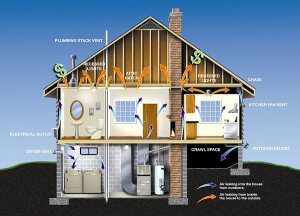What could be easier? Air moves when there is a pressure difference, just like weather highs & lows. For a house, air moves when there is a pressure difference on opposite sides of a hole.
The driving force (pressure) is caused by hot air rising (stack effect), wind, holes in ductwork, or fans. Air pressure principles are discussed in detail on my home performance website.
Drawing fresh air in and letting stale, polluted air out is a good thing for a house. However, people need to breathe-not a house! Let’s bring fresh air in from known places and predetermined quantities. Let’s get rid of bad air at known rates too!
When a house brings air through any hole in the shell of the house, it’s called infiltration. Infiltration brings in fresh air mixed with whatever happens to be handy-pollen, dust, vehicle exhaust, humidity, allergens, hot air, cold air, and etc.
When a house lets out air, the great thing about it is that it lets up water vapor, volatile organic compounds (VOCs), soil gases, body odors and gases, allergens, and all kinds of similar stuff. Water vapor comes from such things as cooking, bathing, breathing, plants, perspiration, and wet clothes. VOCs are odors (gases) coming off anything manufactured. Soil gases include radon. Bodies include people and pets. All of these things pollute our air and need to be let out early and often.
Unfortunately, exfiltration is responsible for letting conditioned air out –the air we spent money to heat, cool, humidify, dehumidify, or clean. Newer houses lose all this air about once every 2 hours. Older ones tend to lose it every hour and twenty minutes. Pre-WWII houses tend to lose it every hour. Then are do-it-yourselfers (DIYs) who remodel and forget to seal up the air holes and lose it every 40 minutes or less. Whoops!
There are a gazillion holes in the shell of a house. Do you seal them all? No, it’s impossible because houses move. So let it move! However, we can seal up the big ones. It’ll be the best bang for your energy buck when you do!
What you’re trying to do is create a robust and resilient air barrier all the way around the shell of the house. Air barriers are systems of materials designed and constructed to control airflow (and vapor flow) between condition space and unconditioned space
For information on how to do DIY air sealing, or understand what your contractor is supposed to do, read the Environmental Protection Agency’s (EPA’s) booklet “A Do-It-Yourself Guide to Sealing and Insulating with ENERGY STAR: Sealing Air Leaks and Adding Insulation”
Diagnosing and correcting air leakage is discussed on my home performance website. My first resource is the book, Residential Energy: Cost Saving and Comfort for Existing Buildings.
Another excellent resource on air sealing is offered by the Green Energy Advisor.
Air sealing is relatively to easiest and most cost effective thing you can do to improve the energy efficiency of your house. Future articles will discuss this topic in detail
As always, if you have any questions or comments, share them with the rest of us by leaving your comments. Otherwise, email me at SherlockHomes@HomeInSight.biz.
Next time, a related subject: Duct Sealing!
Don’t forget to heed our warning though . . .
WARNING! Do not implement any of these solutions without considering the impact on IAQ, moisture control, & heat transfer. A combination of solutions are usually needed to improve health, building durability, comfort, and energy efficiency. Ignoring this warning may lead to disease, deterioration, high energy bills or worse!

Leave a comment